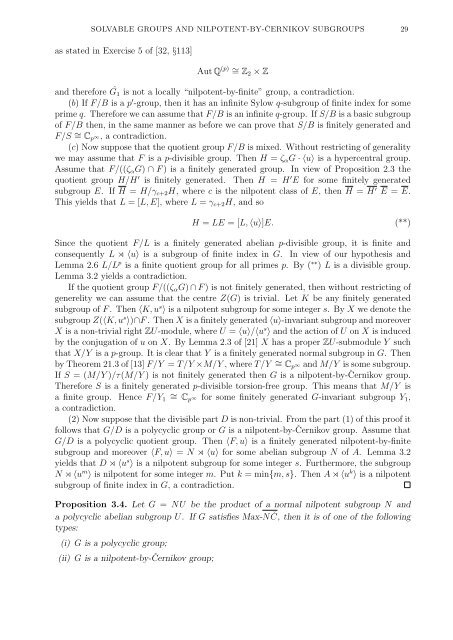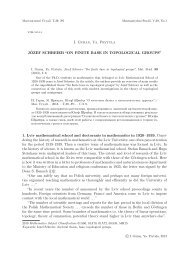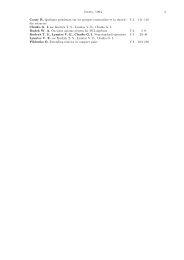SOLVABLE GROUPS WITH MANY CONDITIONS ON NILPOTENT ...
SOLVABLE GROUPS WITH MANY CONDITIONS ON NILPOTENT ...
SOLVABLE GROUPS WITH MANY CONDITIONS ON NILPOTENT ...
You also want an ePaper? Increase the reach of your titles
YUMPU automatically turns print PDFs into web optimized ePapers that Google loves.
<strong>SOLVABLE</strong> <strong>GROUPS</strong> AND <strong>NILPOTENT</strong>-BY-ČERNIKOV SUB<strong>GROUPS</strong> 29<br />
as stated in Exercise 5 of [32, §113]<br />
Aut Q (p) ∼ = Z2 × Z<br />
and therefore Ĝ1 is not a locally “nilpotent-by-finite” group, a contradiction.<br />
(b) If F/B is a p ′ -group, then it has an infinite Sylow q-subgroup of finite index for some<br />
prime q. Therefore we can assume that F/B is an infinite q-group. If S/B is a basic subgroup<br />
of F/B then, in the same manner as before we can prove that S/B is finitely generated and<br />
F/S ∼ = C p ∞, a contradiction.<br />
(c) Now suppose that the quotient group F/B is mixed. Without restricting of generality<br />
we may assume that F is a p-divisible group. Then H = ζ α G · 〈u〉 is a hypercentral group.<br />
Assume that F/((ζ α G) ∩ F ) is a finitely generated group. In view of Proposition 2.3 the<br />
quotient group H/H ′ is finitely generated. Then H = H ′ E for some finitely generated<br />
subgroup E. If H = H/γ c+2 H, where c is the nilpotent class of E, then H = H ′ E = E.<br />
This yields that L = [L, E], where L = γ c+2 H, and so<br />
H = LE = [L, 〈u〉]E. (**)<br />
Since the quotient F/L is a finitely generated abelian p-divisible group, it is finite and<br />
consequently L ⋊ 〈u〉 is a subgroup of finite index in G. In view of our hypothesis and<br />
Lemma 2.6 L/L p is a finite quotient group for all primes p. By ( ∗∗ ) L is a divisible group.<br />
Lemma 3.2 yields a contradiction.<br />
If the quotient group F/((ζ α G) ∩ F ) is not finitely generated, then without restricting of<br />
generelity we can assume that the centre Z(G) is trivial. Let K be any finitely generated<br />
subgroup of F . Then 〈K, u s 〉 is a nilpotent subgroup for some integer s. By X we denote the<br />
subgroup Z(〈K, u s 〉)∩F . Then X is a finitely generated 〈u〉-invariant subgroup and moreover<br />
X is a non-trivial right ZU-module, where U = 〈u〉/〈u s 〉 and the action of U on X is induced<br />
by the conjugation of u on X. By Lemma 2.3 of [21] X has a proper ZU-submodule Y such<br />
that X/Y is a p-group. It is clear that Y is a finitely generated normal subgroup in G. Then<br />
by Theorem 21.3 of [13] F/Y = T/Y ×M/Y , where T/Y ∼ = C p ∞ and M/Y is some subgroup.<br />
If S = (M/Y )/τ(M/Y ) is not finitely generated then G is a nilpotent-by-Černikov group.<br />
Therefore S is a finitely generated p-divisible torsion-free group. This means that M/Y is<br />
a finite group. Hence F/Y 1<br />
∼ = Cp ∞ for some finitely generated G-invariant subgroup Y 1 ,<br />
a contradiction.<br />
(2) Now suppose that the divisible part D is non-trivial. From the part (1) of this proof it<br />
follows that G/D is a polycyclic group or G is a nilpotent-by-Černikov group. Assume that<br />
G/D is a polycyclic quotient group. Then 〈F, u〉 is a finitely generated nilpotent-by-finite<br />
subgroup and moreover 〈F, u〉 = N ⋊ 〈u〉 for some abelian subgroup N of A. Lemma 3.2<br />
yields that D ⋊ 〈u s 〉 is a nilpotent subgroup for some integer s. Furthermore, the subgroup<br />
N ⋊ 〈u m 〉 is nilpotent for some integer m. Put k = min{m, s}. Then A ⋊ 〈u k 〉 is a nilpotent<br />
subgroup of finite index in G, a contradiction.<br />
Proposition 3.4. Let G = NU be the product of a normal nilpotent subgroup N and<br />
a polycyclic abelian subgroup U. If G satisfies Max-NČ, then it is of one of the following<br />
types:<br />
(i) G is a polycyclic group;<br />
(ii) G is a nilpotent-by-Černikov group;









